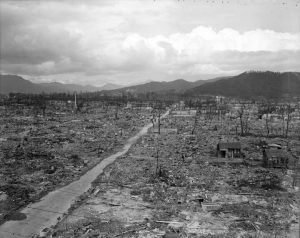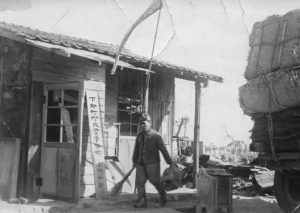Striving to fill voids in Hiroshima, evidence of victims remains—Photos taken by U.S., Part 1: Devastated neighborhood
Oct. 31, 2022
by Kyosuke Mizukawa, Senior Staff Writer
After dropping the atomic bomb on Hiroshima in 1945, the United States sent members of the U.S. Strategic Bombing Survey team and others to investigate the state of destruction of the city, resulting in their taking numerous photographs. The purpose of that work was to investigate the destructive power of the weapon, but examining each of the photos from the viewpoint of the A-bombed city makes clear the tragic devastation, traces of the city from before the bombing, and the path of recovery. In this series, the Chugoku Shimbun will examine the photos against the backdrop of resource information from Hiroshima and testimonies of A-bomb survivors.
On its website, the Hiroshima Peace Memorial Museum, located in the city’s Naka Ward, has made publicly available a database of some 1,000 photos taken by the American survey team. One was taken on October 31, 1945, from the rooftop of the then-Hiroshima Higashi (East) Police Station, located 1.2 kilometers from the hypocenter. That photo reveals the burned ruins of the former area of Shimoyanagi-cho (now Hashimoto-cho and other parts of Naka Ward).
The shacks standing to the right in the photo stand out amid a wide stretch of scorched earth. The photo, taken by the survey team, is of vivid quality for one taken at that time. After the photo was enlarged to the extent possible, a signboard at the entrance of one of the shacks became legible. Although each letter is not clearly visible, the Peace Memorial Museum has posited that the sign reads “Shimoyanagi-cho Neighborhood Association.”
Recovery of neighborhood association
This reporter was able to uncover supporting material in an article carried in the Chugoku Shimbun dated November 10, 1945. A photo used in that first article of a series carried in the paper’s morning edition in November 1945 introduced the progress of recovery for the city’s neighborhood associations. The photo was a close-up of the same shack with the signboard “Shimoyanagi-cho Neighborhood Association Office.” The article explained, “This is the first neighborhood association to open its office after the atomic bombing.” The neighborhood association seems to have been covered in the article as an example of associations in the city that had recovered quickly after the atomic bombing.
However, the article also told of the hardships the people of the neighborhood faced at the time. “We are hurrying to prepare for recovery, but we are at a loss as to how to begin,” said Tsubasa Itadani, then-president of the association. The area was close to the busy shopping area of Hatchobori (now part of Hiroshima’s Naka Ward) and home to about 1,400 people living in 351 households. It was devastated by the atomic bombing of August 6, and by the time the neighborhood association story made it into the paper, there were only 60 people in 20 households.
The article also explained that although some people had erected shacks with great difficulty right after the atomic bombing, the domiciles had been destroyed by the powerful Makurazaki Typhoon that hit Hiroshima in September of that year, setting those people back to square one. The article indicated that the biggest concern at the time was finding housing in which to live. The flag of the neighborhood association, found among the ruins, was raised at the association’s office. “We lost our families, everything, so we are making a go of it by leaning on each other,” Mr. Itadani said in the article.
Nowhere to live in neighborhood
On the other hand, some people had no choice but to move far away.
Keiko Ueda, 93, had lived in the area of Shimoyanagi-cho with her mother. After her mother was killed in the atomic bombing, however, she moved to a relative’s home in the mountainous region of Aido in the town of Jinsekikogen, located in northern Hiroshima Prefecture. She still lives there. “The atomic bombing completely changed my life, as if the world had been turned upside down,” she said.
Before the atomic bombing, her mother, Tokiko Isemura, ran a beauty shop in Shimoyanagi-cho. Her shop was located near the Higashi (East) Yukaku (red light district), and many geisha used to visit her shop. Ms. Ueda began learning Japanese dance at the age of three at a place near her mother’s shop. She said, “I thought I would establish myself when I grew up through dance.”
Ms. Ueda was 16 and a fourth-year student at Hiroshima Jogakuin Senior High School at that time. She experienced the atomic bombing near the Hiroshima train station on her way to a munitions factory where she had been mobilized for work. Fortuitously, she survived but had to walk for several days in search of her mother, who had been working at her beauty shop on August 6. Ms. Ueda discovered that her mother had fled to the East Drill Ground (now part of Hiroshima’s Higashi Ward), but she was unable to find her or her remains there.
The beauty shop, which also served as their home, had completely vanished in the bombing, and her aunts, who had lived next door, were also killed. With nowhere to stay, she moved to the Aido region in September of that year to live at the home of a relative, whose son she married the following year. She worked hard on the farm, although she had no experience in such work, and raised four children.
Now, Ms. Ueda has 10 grandchildren and nine great-grandchildren. When interviewed, she smiled and said, “I’m at my happiest now.” However, her smile faded when she looked at a photo of her ruined hometown of Shimoyanagi-cho. “Such a situation must never happen again. I’m on the verge of tears at the news of the Russian invasion of Ukraine, as I recall what I went through in those days.” She now sincerely hopes for peace as she herself lives a peaceful life.
(Originally published on October 31, 2022)
After dropping the atomic bomb on Hiroshima in 1945, the United States sent members of the U.S. Strategic Bombing Survey team and others to investigate the state of destruction of the city, resulting in their taking numerous photographs. The purpose of that work was to investigate the destructive power of the weapon, but examining each of the photos from the viewpoint of the A-bombed city makes clear the tragic devastation, traces of the city from before the bombing, and the path of recovery. In this series, the Chugoku Shimbun will examine the photos against the backdrop of resource information from Hiroshima and testimonies of A-bomb survivors.
Difficulties in recovery, some people unable to return
On its website, the Hiroshima Peace Memorial Museum, located in the city’s Naka Ward, has made publicly available a database of some 1,000 photos taken by the American survey team. One was taken on October 31, 1945, from the rooftop of the then-Hiroshima Higashi (East) Police Station, located 1.2 kilometers from the hypocenter. That photo reveals the burned ruins of the former area of Shimoyanagi-cho (now Hashimoto-cho and other parts of Naka Ward).
The shacks standing to the right in the photo stand out amid a wide stretch of scorched earth. The photo, taken by the survey team, is of vivid quality for one taken at that time. After the photo was enlarged to the extent possible, a signboard at the entrance of one of the shacks became legible. Although each letter is not clearly visible, the Peace Memorial Museum has posited that the sign reads “Shimoyanagi-cho Neighborhood Association.”
Recovery of neighborhood association
This reporter was able to uncover supporting material in an article carried in the Chugoku Shimbun dated November 10, 1945. A photo used in that first article of a series carried in the paper’s morning edition in November 1945 introduced the progress of recovery for the city’s neighborhood associations. The photo was a close-up of the same shack with the signboard “Shimoyanagi-cho Neighborhood Association Office.” The article explained, “This is the first neighborhood association to open its office after the atomic bombing.” The neighborhood association seems to have been covered in the article as an example of associations in the city that had recovered quickly after the atomic bombing.
However, the article also told of the hardships the people of the neighborhood faced at the time. “We are hurrying to prepare for recovery, but we are at a loss as to how to begin,” said Tsubasa Itadani, then-president of the association. The area was close to the busy shopping area of Hatchobori (now part of Hiroshima’s Naka Ward) and home to about 1,400 people living in 351 households. It was devastated by the atomic bombing of August 6, and by the time the neighborhood association story made it into the paper, there were only 60 people in 20 households.
The article also explained that although some people had erected shacks with great difficulty right after the atomic bombing, the domiciles had been destroyed by the powerful Makurazaki Typhoon that hit Hiroshima in September of that year, setting those people back to square one. The article indicated that the biggest concern at the time was finding housing in which to live. The flag of the neighborhood association, found among the ruins, was raised at the association’s office. “We lost our families, everything, so we are making a go of it by leaning on each other,” Mr. Itadani said in the article.
Nowhere to live in neighborhood
On the other hand, some people had no choice but to move far away.
Keiko Ueda, 93, had lived in the area of Shimoyanagi-cho with her mother. After her mother was killed in the atomic bombing, however, she moved to a relative’s home in the mountainous region of Aido in the town of Jinsekikogen, located in northern Hiroshima Prefecture. She still lives there. “The atomic bombing completely changed my life, as if the world had been turned upside down,” she said.
Before the atomic bombing, her mother, Tokiko Isemura, ran a beauty shop in Shimoyanagi-cho. Her shop was located near the Higashi (East) Yukaku (red light district), and many geisha used to visit her shop. Ms. Ueda began learning Japanese dance at the age of three at a place near her mother’s shop. She said, “I thought I would establish myself when I grew up through dance.”
Ms. Ueda was 16 and a fourth-year student at Hiroshima Jogakuin Senior High School at that time. She experienced the atomic bombing near the Hiroshima train station on her way to a munitions factory where she had been mobilized for work. Fortuitously, she survived but had to walk for several days in search of her mother, who had been working at her beauty shop on August 6. Ms. Ueda discovered that her mother had fled to the East Drill Ground (now part of Hiroshima’s Higashi Ward), but she was unable to find her or her remains there.
The beauty shop, which also served as their home, had completely vanished in the bombing, and her aunts, who had lived next door, were also killed. With nowhere to stay, she moved to the Aido region in September of that year to live at the home of a relative, whose son she married the following year. She worked hard on the farm, although she had no experience in such work, and raised four children.
Now, Ms. Ueda has 10 grandchildren and nine great-grandchildren. When interviewed, she smiled and said, “I’m at my happiest now.” However, her smile faded when she looked at a photo of her ruined hometown of Shimoyanagi-cho. “Such a situation must never happen again. I’m on the verge of tears at the news of the Russian invasion of Ukraine, as I recall what I went through in those days.” She now sincerely hopes for peace as she herself lives a peaceful life.
(Originally published on October 31, 2022)









